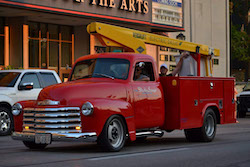
The job you do will dictate the type of fire extinguisher for your truck. You may even need more than one if your job comes with the risk of different types of fires. Fire extinguishers also have a “use by” date. If you are required by state law to have a fire extinguisher on your truck, you’ll need to remember to check the date on the fire extinguishers and replace them at the appropriate time.
Types of Fires
When fighting a fire you need to know what type it is. If you use a fire extinguisher for combustibles on a gas fire, you could end up spreading the fire. The different types of fires determine which type of fire extinguisher you need to use.
- Class A fires are typical combustibles, like trash, wood, paper, plastics and cloth.
- Class B fires are flammable liquids. These include paint, gasoline and petroleum oil. Flammable gasses are also Class B fires, and these include butane and propane. Grease and cooking oil are not considered Class B fires.
- Class C fires are energized electrical equipment, including appliances, motors, transformer and engines. Once you remove the power, the Class C fire becomes another type of fire, depending on what is burning.
- Class D fires are combustible metals including magnesium, sodium, aluminum and potassium.
- Class K fires are typically kitchen fires involving vegetable fats, cooking oil, animal fats and cooking grease. You may have a Class K fire in some place other than a kitchen.
Depending on the material burning, you may use more than one type of fire extinguisher on the fire. When choosing a fire extinguisher for your truck, choose one that might cover more than one type of expected fire, if possible.
Fire Extinguishers and Their Uses
The tag on the fire extinguisher will tell you the expiration date and what type of fire you may use the extinguisher for. If you are not familiar with the different types of fires, you should learn about them so you don’t have to waste precious seconds or even minutes determining which fire extinguisher to grab. You’ll be able to look at the color-coded identification on the tag and grab the fire extinguisher without reading the label.
A carbon dioxide extinguisher is for Class B and C fires. The carbon dioxide removes oxygen and the heat from the fire to extinguish it. Do not try to use a carbon dioxide extinguisher on a Class A fire, as it is usually ineffective.
A dry chemical extinguisher for Class B and C fires. Using any other fire extinguisher on these fires could cause the fire to reignite. However, if you have a multipurpose dry chemical extinguisher, it is also effective on Class A fires. This type of fire extinguisher interrupts the chemical reaction of the fire.
A wet chemical extinguisher is relatively new and it removes the heat from the fire. It also prevents re-ignition by keeping oxygen away from the fuel. These are used on Class K fires of the type found in commercial kitchens that use high efficiency deep fat fryers.
A clean agent extinguisher, also known as a halogenated extinguisher is for Class B and C fires. This type interrupts the chemical reaction of the fire.
A dry powder extinguisher works only on Class D fires. They do not work at all on any other type of fire. They starve the fire of oxygen.
A water mist extinguisher works on Class A fires, but may be used safely on Class C fires. This type removes the heat from the fire.
A cartridge operated dry chemical extinguisher is for Class A, B and C fires. It interrupts the chemical reaction needed to fuel the fire.
Contact Drake-Scruggs for all of your commercial truck needs, including truck bodies and work truck storage solutions.

